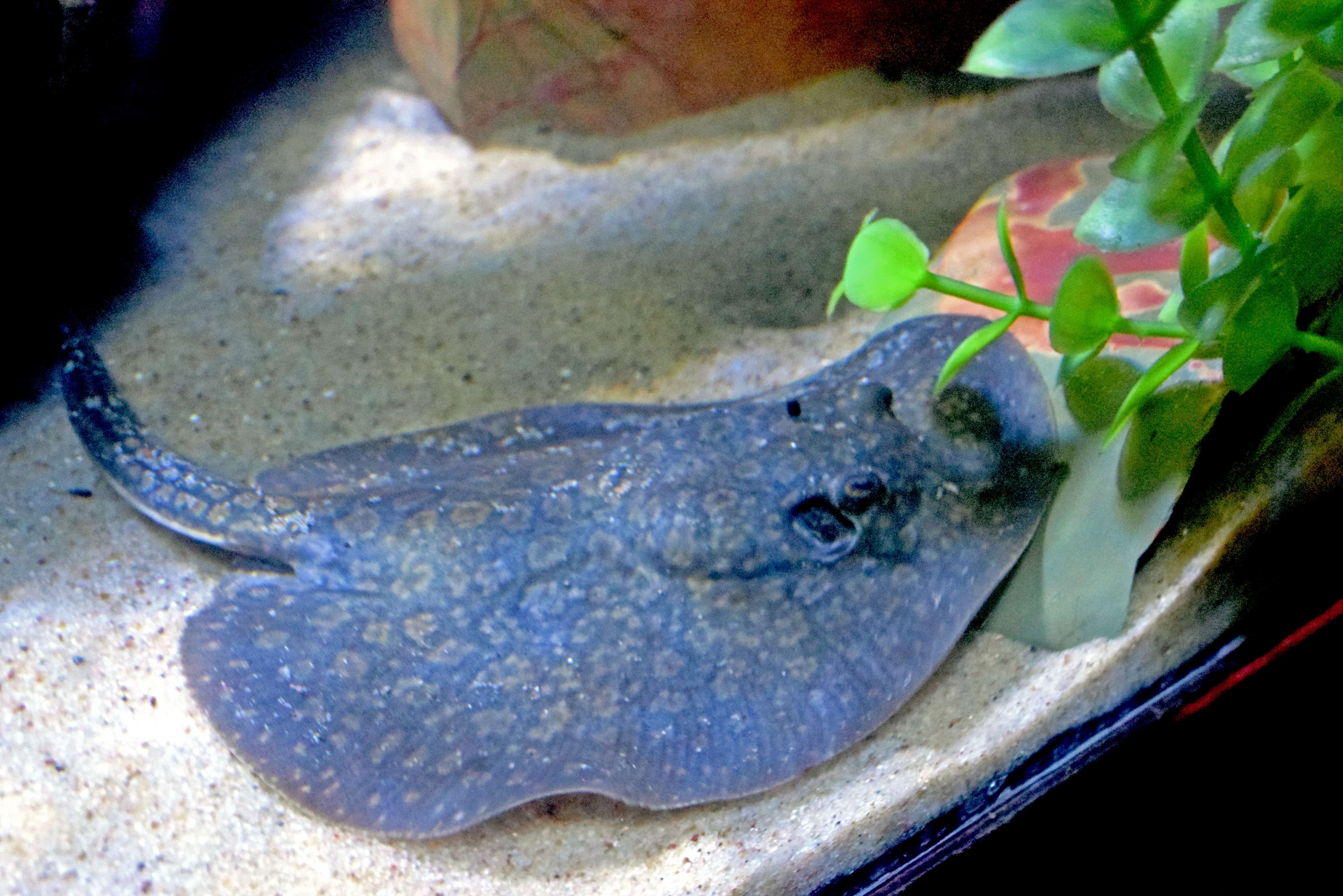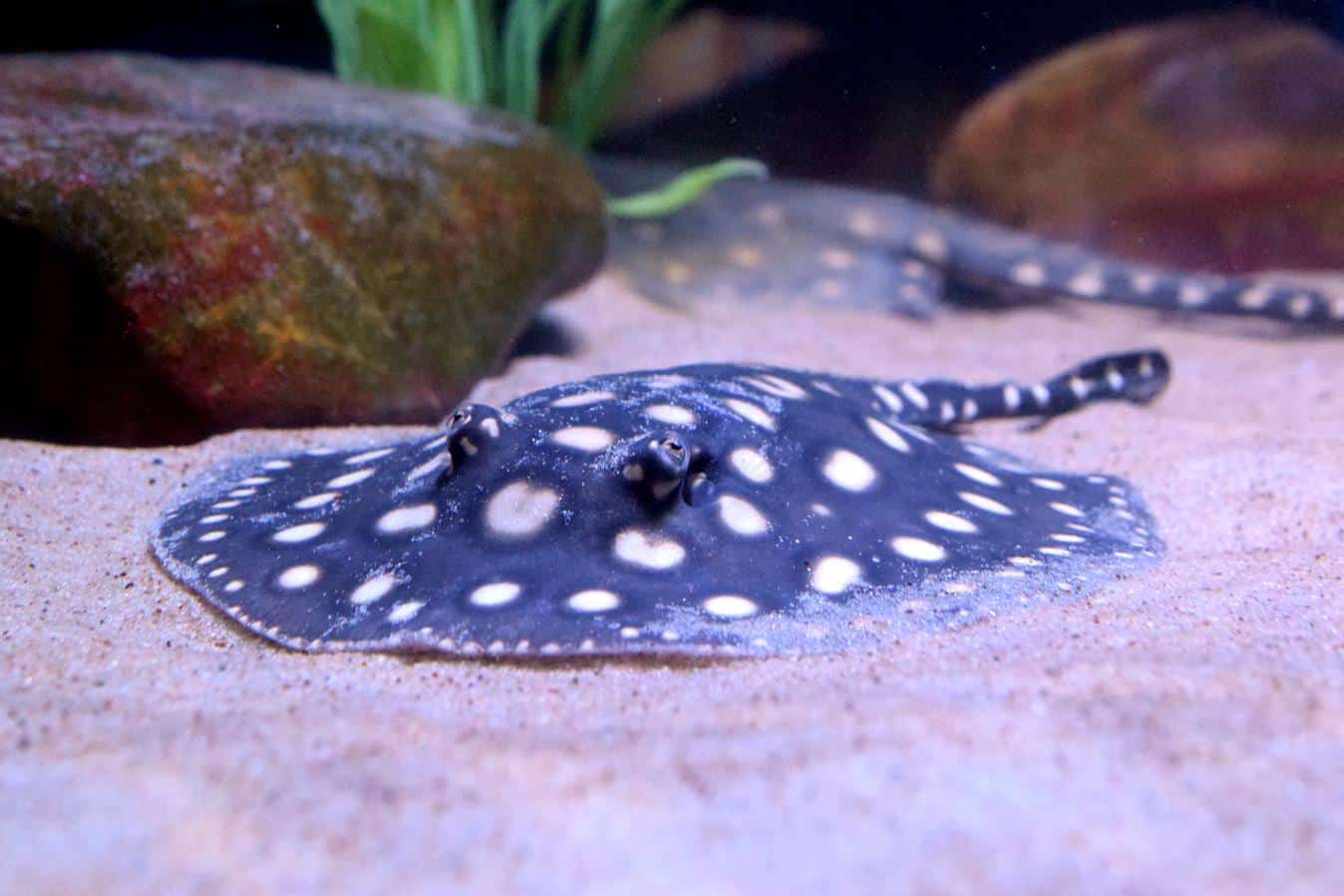Perhaps the jewel of our freshwater department, our freshwater stingray tank has been known to turn heads. Many customers are captivated by these misunderstood fish and have questions on how to properly care for them. Stingrays are extraordinary animals with personality of iconic identity however; people are usually deterred from purchasing them because of the size, difficulty in care and cost of the animal.
About Rays/Behavior:
Freshwater Stingrays can be found in parts of Asia and the Americas. In our store and throughout the hobby, the Stingrays we see in home aquariums are almost entirely indigenous to Parts of South America throughout the Amazon and connected basins. They are true to their name in that they have the potential to sting! Their tail is equipped with a serrated barb covered in a sac of tissue filled with venom. As the serrated barb impales its victim it tears open the venom filled sac and releases venom into the wound it creates when it stings. The wound can range from very painful to a serious injury/infection and should receive immediate medical attention. Typically they do not sting! Stingrays are intelligent fish and learn their environment well over time and become very used to or even “friendly” with their owners. They are Predators and will try to engulf smaller fish but their barb is a last resort defense against something harming them. It is extremely unlikely that they will sting their owner; typically it only occurs when they are stepped on in the wild. In the home aquarium, owners should be cautious while cleaning the tank not to bump into them as they may be out of sight, buried in sand. I would recommend approaching them with caution, especially new arrivals that are getting used to the tank and their owners hands in it. After a number of weeks in captivity, they become more accustom to people and can even be taught to be hand fed in many cases.
Water Quality:
Stingrays have high standards for Water Quality and their size and appetite can make that difficult to maintain. Stingrays are not great first fish, they are very much like discus in terms of water quality. They prefer a tank with softer, more acidic water. This can be difficult to maintain, most people have harder water coming out of their faucet with a ph of 7.4-7.8. There are several products on the market to help achieve a lower ph and softer water but are not always stable. Powder buffers can lower the ph of tap water temporarily but should be tested in the days following as the ph can climb back up sometimes overnight. With rays collected from the wild, a stable ph of 6.5-7.0 is ideal to get them eating and accustom to the tank. Using a ratio of a quarter to a half R.O. water to tap water, most people will end up with a stable ph and hardness in that ideal range. Many of the stingrays we are starting to receive now are bred in captivity and born in water with a ph of 7.2-7.4 and do not require a lower ph. Eventually, even a once wild ray can be acclimated to ph in that range.
They eat a lot and can produce a lot of waste! We recommend two filters or an appropriate sized wet/dry system to accommodate their bio load. The filters should be well maintained and the substrate should be vacuumed at least monthly. They are also very sensitive medications commonly sold in the aquarium trade and should owners should never use anything with harsh chemicals like copper and quick cure. They can however tolerate many herbal and natural medications.
Diet:
Stingrays can be picky eaters and ideally should eat at least once a day. When acclimated to a new tank, rays may not immediately accept food. The captive bred stingrays we receive are raised on various worms and frozen food. Wild rays can be more stubborn, often refusing prepared and frozen foods at first. Stingrays love live worms and even the pickiest of rays should accept live black worms or earthworms. These are great foods to get any rays to eat but they can lack in nutrition and long term and should be transitioned to a varied frozen diet or ideally a pellet food. Good frozen foods include mysis shrimp, silversides, bloodworms, krill, and even fresh shrimp from the local market.
Tankmates:
Anything that can remotely fit in the mouth of a stingray is fair game! They cane be housed with more peaceful cichlids that are appropriately sized. They should not be housed with aggressive or “nippy” fish that may pester them or pick at them. Ideal tank mates include larger Discus, More peaceful geophagus species, bigger clown loaches, various knife fish like black ghosts and other stingrays. Stingrays don’t mind each other and can be house together so long as they have enough space and filtration.
Tank size:
Stingrays range in size with males staying smaller than females. Typically our motoro stingrays and hybrid stingrays will reach a disc length of over 18” for males and with females reaching over 24”. Reticulated stingrays, also known as teacup stingrays, are less colorful and much more sensitive but tend to reach a disc length of around 11” for males and 18” for females. A smaller or young stingray can be raised in a 3-4 foot by 18” tank like a 40 or 75 gallon however they will out grow these. A single male can be housed in a 120 gallon aquarium that is 4ft by 2ft, multiple rays or females should be in tanks at least 4ft by 3ft wide. The width of the tank is the most important measurement and any ray should be in a tank at least 24” wide.
Types of stingrays:
Wild stingrays are becoming more difficult to obtain with new restrictions coming up every year or so. Motoro stingrays are the most hardy and are the most common stingray sold. They make a great first ray and have beautiful orange spots. They also readily accept various foods. Teacup stingrays, also known as reticulated rays, are the most sensitive and tend to stay smaller. They are available when collected from the wild and may take time to adjust to the home aquarium. Teacups require pristine water quality, are picky eater and should only be kept by the advanced aquarist. Recently we have been moving more towards tank aquacultured singrays from a breeder. This allow us to keep and sell rays like black diamonds, which are endangered in the wild and illegal to collect. Our breeder provided us with high quality hybrid rays and black diamond stingrays. Being born and raised in aquariums, these rays are hardier and more accustom to tank life. They readily eat frozen and often prepared foods, they have less risk of disease and are happy in a normal freshwater ph range of 7.0-7.6.
While they are not for the novice aquarist, freshwater stingrays can make a very rewarding aquarium pet and can live a long time if given the proper home and care.


